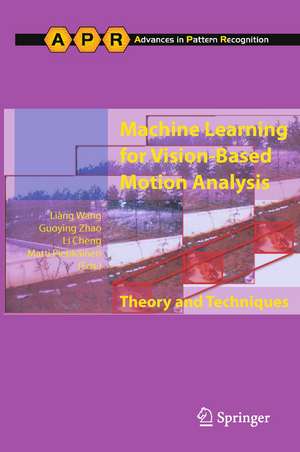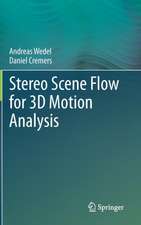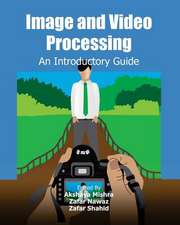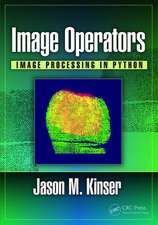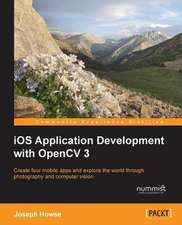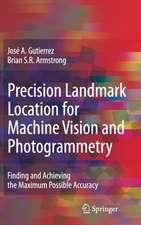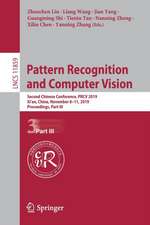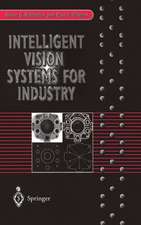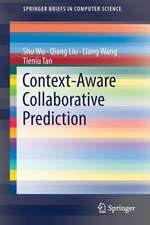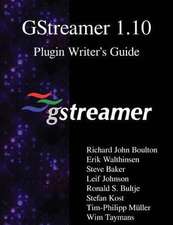Machine Learning for Vision-Based Motion Analysis: Theory and Techniques: Advances in Computer Vision and Pattern Recognition
Editat de Liang Wang, Guoying Zhao, Li Cheng, Matti Pietikäinenen Limba Engleză Paperback – 2 ian 2013
Developed from expert contributions to the first and second International Workshop on Machine Learning for Vision-Based Motion Analysis, this important text/reference highlights the latest algorithms and systems for robust and effective vision-based motion understanding from a machine learning perspective. Highlighting the benefits of collaboration between the communities of object motion understanding and machine learning, the book discusses the most active forefronts of research, including current challenges and potential future directions.
Topics and features: provides a comprehensive review of the latest developments in vision-based motion analysis, presenting numerous case studies on state-of-the-art learning algorithms; examines algorithms for clustering and segmentation, and manifold learning for dynamical models; describes the theory behind mixed-state statistical models, with a focus on mixed-state Markov models that take into account spatial and temporal interaction; discusses object tracking in surveillance image streams, discriminative multiple target tracking, and guidewire tracking in fluoroscopy; explores issues of modeling for saliency detection, human gait modeling, modeling of extremely crowded scenes, and behavior modeling from video surveillance data; investigates methods for automatic recognition of gestures in Sign Language, and human action recognition from small training sets.
Researchers, professional engineers, and graduate students in computer vision, pattern recognition and machine learning, will all find this text an accessible survey of machine learning techniques for vision-based motion analysis. The book will also be of interest to all who work with specific vision applications, such as surveillance, sport event analysis, healthcare, video conferencing, and motion video indexing and retrieval.
| Toate formatele și edițiile | Preț | Express |
|---|---|---|
| Paperback (1) | 991.46 lei 43-57 zile | |
| SPRINGER LONDON – 2 ian 2013 | 991.46 lei 43-57 zile | |
| Hardback (1) | 1004.48 lei 43-57 zile | |
| SPRINGER LONDON – 23 noi 2010 | 1004.48 lei 43-57 zile |
Din seria Advances in Computer Vision and Pattern Recognition
- 20%
 Preț: 998.36 lei
Preț: 998.36 lei - 20%
 Preț: 409.78 lei
Preț: 409.78 lei - 20%
 Preț: 654.70 lei
Preț: 654.70 lei - 20%
 Preț: 775.30 lei
Preț: 775.30 lei - 20%
 Preț: 867.13 lei
Preț: 867.13 lei - 20%
 Preț: 241.87 lei
Preț: 241.87 lei - 20%
 Preț: 659.83 lei
Preț: 659.83 lei - 20%
 Preț: 1084.17 lei
Preț: 1084.17 lei - 20%
 Preț: 328.60 lei
Preț: 328.60 lei - 20%
 Preț: 650.08 lei
Preț: 650.08 lei - 20%
 Preț: 644.66 lei
Preț: 644.66 lei - 20%
 Preț: 652.54 lei
Preț: 652.54 lei - 20%
 Preț: 646.80 lei
Preț: 646.80 lei - 20%
 Preț: 993.60 lei
Preț: 993.60 lei - 20%
 Preț: 1174.92 lei
Preț: 1174.92 lei - 20%
 Preț: 646.80 lei
Preț: 646.80 lei - 20%
 Preț: 672.36 lei
Preț: 672.36 lei - 20%
 Preț: 1166.52 lei
Preț: 1166.52 lei - 20%
 Preț: 920.33 lei
Preț: 920.33 lei - 20%
 Preț: 825.78 lei
Preț: 825.78 lei - 20%
 Preț: 666.58 lei
Preț: 666.58 lei - 18%
 Preț: 953.65 lei
Preț: 953.65 lei - 20%
 Preț: 999.35 lei
Preț: 999.35 lei - 20%
 Preț: 655.02 lei
Preț: 655.02 lei - 20%
 Preț: 595.16 lei
Preț: 595.16 lei - 20%
 Preț: 647.61 lei
Preț: 647.61 lei - 20%
 Preț: 658.33 lei
Preț: 658.33 lei - 20%
 Preț: 1649.61 lei
Preț: 1649.61 lei - 20%
 Preț: 994.08 lei
Preț: 994.08 lei - 20%
 Preț: 1062.57 lei
Preț: 1062.57 lei - 20%
 Preț: 985.16 lei
Preț: 985.16 lei - 20%
 Preț: 640.35 lei
Preț: 640.35 lei - 20%
 Preț: 656.03 lei
Preț: 656.03 lei - 18%
 Preț: 950.52 lei
Preț: 950.52 lei - 20%
 Preț: 652.41 lei
Preț: 652.41 lei - 20%
 Preț: 644.81 lei
Preț: 644.81 lei - 20%
 Preț: 996.40 lei
Preț: 996.40 lei
Preț: 991.46 lei
Preț vechi: 1239.33 lei
-20% Nou
Puncte Express: 1487
Preț estimativ în valută:
189.72€ • 198.58$ • 157.90£
189.72€ • 198.58$ • 157.90£
Carte tipărită la comandă
Livrare economică 31 martie-14 aprilie
Preluare comenzi: 021 569.72.76
Specificații
ISBN-13: 9781447126072
ISBN-10: 1447126076
Pagini: 388
Ilustrații: XIV, 372 p.
Dimensiuni: 155 x 235 x 20 mm
Greutate: 0.54 kg
Ediția:2011
Editura: SPRINGER LONDON
Colecția Springer
Seria Advances in Computer Vision and Pattern Recognition
Locul publicării:London, United Kingdom
ISBN-10: 1447126076
Pagini: 388
Ilustrații: XIV, 372 p.
Dimensiuni: 155 x 235 x 20 mm
Greutate: 0.54 kg
Ediția:2011
Editura: SPRINGER LONDON
Colecția Springer
Seria Advances in Computer Vision and Pattern Recognition
Locul publicării:London, United Kingdom
Public țintă
ResearchCuprins
Part I: Manifold Learning and Clustering/Segmentation.- Practical Algorithms of Spectral Clustering: Toward Large-Scale Vision-Based Motion Analysis.- Riemannian Manifold Clustering and Dimensionality Reduction for Vision-based Analysis.- Manifold Learning for Multi-dimensional Auto-regressive Dynamical Models.- Part II: Tracking.- Mixed-state Markov Models in Image Motion Analysis.- Learning to Detect Event Sequences in Surveillance Streams at Very Low Frame Rate.- Discriminative Multiple Target Tracking.- A Framework of Wire Tracking in Image Guided Interventions.- Part III: Motion Analysis and Behavior Modeling.- An Integrated Approach to Visual Attention Modeling for Saliency Detection in Videos.- Video-based Human Motion Estimation by Part-whole Gait Manifold Learning.- Spatio-temporal Motion Pattern Models of Extremely Crowded Scenes.- Learning Behavioral Patterns of Time Series for Video-surveillance.- Part IV: Gesture and Action Recognition.- Recognition of Spatiotemporal Gestures in Sign Language using Gesture Threshold HMMs.- Learning Transferable Distance Functions for Human Action Recognition.
Recenzii
From the reviews:
“The successes of the First and Second International Workshops on Machine Learning for Vision-Based Motion Analysis, which were held in 2008 and 2009, prompted this book. The book consists of four parts, and each part includes a number of freestanding chapters. … This book provides a comprehensive introduction to machine learning for vision-based motion analysis. I would recommend it to students and researchers who are interested in learning about the topic.” (J. P. E. Hodgson, ACM Computing Reviews, June, 2011)
“The successes of the First and Second International Workshops on Machine Learning for Vision-Based Motion Analysis, which were held in 2008 and 2009, prompted this book. The book consists of four parts, and each part includes a number of freestanding chapters. … This book provides a comprehensive introduction to machine learning for vision-based motion analysis. I would recommend it to students and researchers who are interested in learning about the topic.” (J. P. E. Hodgson, ACM Computing Reviews, June, 2011)
Textul de pe ultima copertă
Techniques of vision-based motion analysis aim to detect, track, identify, and generally understand the behavior of objects in image sequences. With the growth of video data in a wide range of applications from visual surveillance to human-machine interfaces, the ability to automatically analyze and understand object motions from video footage is of increasing importance. Among the latest developments in this field is the application of statistical machine learning algorithms for object tracking, activity modeling, and recognition.
Developed from expert contributions to the first and second International Workshop on Machine Learning for Vision-Based Motion Analysis, this important text/reference highlights the latest algorithms and systems for robust and effective vision-based motion understanding from a machine learning perspective. Highlighting the benefits of collaboration between the communities of object motion understanding and machine learning, the book discusses the most active forefronts of research, including current challenges and potential future directions.
Topics and features:
Dr. Liang Wang is a lecturer at the Department of Computer Science at the University of Bath, UK, and is also affiliated to the National Laboratory of Pattern Recognition in Beijing, China. Dr. Guoying Zhao is an adjunct professor at the Department of Electrical and Information Engineering at the University of Oulu, Finland. Dr. Li Cheng is a research scientist at the Agency for Science, Technology and Research (A*STAR), Singapore. Dr. Matti Pietikäinen is Professor of Information Technology at the Department of Electrical and Information Engineering at the University of Oulu, Finland.
Developed from expert contributions to the first and second International Workshop on Machine Learning for Vision-Based Motion Analysis, this important text/reference highlights the latest algorithms and systems for robust and effective vision-based motion understanding from a machine learning perspective. Highlighting the benefits of collaboration between the communities of object motion understanding and machine learning, the book discusses the most active forefronts of research, including current challenges and potential future directions.
Topics and features:
- Provides a comprehensive review of the latest developments in vision-based motion analysis, presenting numerous case studies on state-of-the-art learning algorithms
- Examines algorithms for clustering and segmentation, and manifold learning for dynamical models
- Describes the theory behind mixed-state statistical models, with a focus on mixed-state Markov models that take into account spatial and temporal interaction
- Discusses object tracking in surveillance image streams, discriminative multiple target tracking, and guidewire tracking in fluoroscopy
- Explores issues of modeling for saliency detection, human gait modeling, modeling of extremely crowded scenes, and behavior modeling from video surveillance data
- Investigates methods for automatic recognition of gestures in Sign Language, and human action recognition from small training sets
Dr. Liang Wang is a lecturer at the Department of Computer Science at the University of Bath, UK, and is also affiliated to the National Laboratory of Pattern Recognition in Beijing, China. Dr. Guoying Zhao is an adjunct professor at the Department of Electrical and Information Engineering at the University of Oulu, Finland. Dr. Li Cheng is a research scientist at the Agency for Science, Technology and Research (A*STAR), Singapore. Dr. Matti Pietikäinen is Professor of Information Technology at the Department of Electrical and Information Engineering at the University of Oulu, Finland.
Caracteristici
Provides a comprehensive and accessible review of vision-based motion analysis Highlights the latest algorithms and systems for robust and effective vision-based motion understanding from a machine learning perspective Describes the benefits of collaboration between the communities of object motion understanding and machine learning Includes supplementary material: sn.pub/extras
